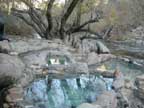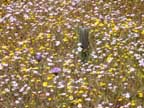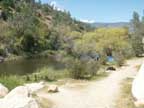
May 2-4, 2003

 This
Astro 28 section will focus a bit more on planetary processes and the geological
forces which have shaped the inner planets. An excellent place for this is the
geologically young Southern Sierra, where processes associated with thin crustal
zones can be seen clearly. As with Astro 28F, signups begin at 5pm on Feb 12
in room 705. A $15 camping deposit at this time secures your place and gives
you permission to add the class - there is no registration for these classes
before the Feb 12 signups. There's space for 27 people. As of March 2, the course
has filled and has 8 on the waiting list.
This
Astro 28 section will focus a bit more on planetary processes and the geological
forces which have shaped the inner planets. An excellent place for this is the
geologically young Southern Sierra, where processes associated with thin crustal
zones can be seen clearly. As with Astro 28F, signups begin at 5pm on Feb 12
in room 705. A $15 camping deposit at this time secures your place and gives
you permission to add the class - there is no registration for these classes
before the Feb 12 signups. There's space for 27 people. As of March 2, the course
has filled and has 8 on the waiting list.
An on-campus session will be held in the planetarium (room 706) on Wednesday evening April 30 at 5pm where we'll distribute maps, decide on food assignments, carpools, and present a planetarium show / lecture on solar system formation, the nature of lunar grazing occultations, and astronomical highlights of our trip. The on-campus meeting is required for full credit.
Our campsite is at a forest service campground near to Miracle Hot Springs on the lower Kern River, about 30 miles east of Bakersfield - a 5 hour drive from Cabrillo. The campsites are suitable for tent camping only (no RV's), with fire rings, water, bathrooms, and tables all close to the river shore. We'll have group dinners on Friday and Saturday around the campfire, and Rick will cook up his famous crepe breakfasts on Saturday and Sunday, with a little help from student contributions. Here's a topo map of the area.
Lunar Graze
The highlight of this trip is the Saturday evening graze of a 7th magnitude star by the cresent moon. Watch as the star disappears and reappears behind the mountains and valleys on the edge of the moon. Visible only from a very narrow track which passes just a few miles from our campsite. Students will assist in taking data, which is valuable for scientific purposes. Grazes are our best means of measuring the precise position of the moon relative to the stars and mapping the edge of the moon. The U.S. Naval Observatory has even seen to it that trips to observe and report data on these events are tax deductable! Learn more about lunar occultations and lunar grazing occultations - one of the few observing projects that amateur astronomers can do which is scientifically valuable - at the IOTA website.
Spring Skies
We'll also have campfire lectures on general astronomy, and the geology of the southern Sierra as contrasted with that of other planets. The spring sky faces the north galactic pole, with a clear view out of our galaxy into the deep cosmos. We will have views of distant galaxies in the great Virgo and Coma clusters, and the Whirlpool galaxy in the Big Dipper. Jupiter will stand high in the evening sky in Leo, near the cresent moon. Late in the evening the summer Milky Way will begin to rise, with the star formation regions of the Sagittarius spiral arm and the finest globular star clusters in the sky.
Bits 'O Halley's Comet!
We pass through the orbit of Halley's Comet this week. The best observing for us will be on Sunday morning before dawn. I'm game to get up early and we can watch the eta aquarid meteor shower that results from bits of rock burning up in our upper atmosphere from this comet. This is the strongest meteor shower of the year for southern hemisphere observers, as strong at the Perseids are in the northern hemisphere. Here in the north we should expect about 15 meteors/hr from the shower, just before dawn. In addition there should be about 20 random meteors per hour at this time of night, giving us an arcing sparkler often enough to keep us awake I believe. The radiant rises about 2:40 am PDT and for the 20 minutes or so following this we can see spectacular "earth grazers" - meteors which just graze the earth's upper atmosphere and therefore have very long trails, often traversing the entire sky.
Solar Study
We'll have a solar filter'ed 8" Meade telescope on hand to show you sunspots and explain their cause, morphology, and the sunspot cycle.
Hot Springs
Hot springs are formed from faulting and magma chambers which have fingers projecting through the earth's crust and close to the surface. An exhaustive list of all hot springs in California can be found here. Miracle Hot Springs is a short walk from our campsite and will allow us to study this process in exquisite detail during the relaxtion portions of our weekend. Check out website descriptions here and here. Our camp is on the Kern River, the largest river in the southern Sierra and an excellent example of a young river system cutting through recent granite exposures. Faulting related to the southern Sierra proximity to the transverse ranges of Southern California produce hot springs, several of which are on the lower Kern River. Read about them here.
 Remington Hot Springs is just 2 miles downriver from our campground. It
has 3 pools clustered on the river near some beautiful oaks. Check out more
views of this spot here and another description
here. This is probably
the best bet for us since Miracle Hot Springs' tubs have just been demolished
as of April '03 (see below).
Remington Hot Springs is just 2 miles downriver from our campground. It
has 3 pools clustered on the river near some beautiful oaks. Check out more
views of this spot here and another description
here. This is probably
the best bet for us since Miracle Hot Springs' tubs have just been demolished
as of April '03 (see below).
Delonegha Hot Springs is a series of hot springs a few miles farther south on the Kern. Unfortunately they are on fenced private property. Democrat Hot Springs is farther south and also on private property with a full-time caretaker.
I'll distribute a take-home final exam on Sunday morning. This and your attendence at all sessions will be the basis for your grade. CR/NC option is available.
 My
Scouting Trip - Apr. 19, 2003
My
Scouting Trip - Apr. 19, 2003I drove out to our site and checked it out. It's beautiful there! Especially this time of year, with wildflowers covering the hillsides. All the camp sites are right on the river. If you arrive early, please try and get sites 22-26 at the far end of the camp road. At the end of the road we will also be able to park extra vehicles. Alas, there is only 1 vehicle allowed per campsite and we have 4 sites, so some vehicle will probably have to be parked down the road after unloading. However if we get sites 22-26 we can park extra cars right at our sites.
 Here
is a view of Hobo campground, which is 26 campsites all strung along the narrow
canyon and on the river. Astronomy viewing will be easiest from sites 22-26.
These sites are at the bottom of this picture, at the turnaround of the camp
road. This is also the beginning of a trail which winds north along the river
to Sandy Flat campground a mile or so away. Each campsite has a permanent table,
water spigot, and good flat grassy areas for setting up tents. Restrooms are
there on-site and a small store is in Bodfish 3 miles away.
Here
is a view of Hobo campground, which is 26 campsites all strung along the narrow
canyon and on the river. Astronomy viewing will be easiest from sites 22-26.
These sites are at the bottom of this picture, at the turnaround of the camp
road. This is also the beginning of a trail which winds north along the river
to Sandy Flat campground a mile or so away. Each campsite has a permanent table,
water spigot, and good flat grassy areas for setting up tents. Restrooms are
there on-site and a small store is in Bodfish 3 miles away.
 Site
13 is also a good one for astronomy, shown in the picture at right. Sites on
either side are shaded but good for tents and staying out of the sun. Sites
5 and 6 are also good for astronomy, but parking is tight.
Site
13 is also a good one for astronomy, shown in the picture at right. Sites on
either side are shaded but good for tents and staying out of the sun. Sites
5 and 6 are also good for astronomy, but parking is tight.
 The
hot springs is a short walk south. At the entrance to the campground you'll
see an obvious sign "Miracle Hot Springs". On my visit, the large
parking lot was empty - on a Saturday! Turns out that the water in the tubs
was not being kept clean enough and the bacteria count exceeded state levels.
Since the Kern River is the water source for Bakersfield downstream, the forest
service was required to knock down the cement tubs. This happened just before
my visit. I did however see people making rock walls at the river to hold the
very hot water after it emerges from the ground, and kids laying in the resulting
hot pools, shown at left. I assume that in the following 3 weeks before our
arrival that campers will put together something to help us enjoy these springs.
The
hot springs is a short walk south. At the entrance to the campground you'll
see an obvious sign "Miracle Hot Springs". On my visit, the large
parking lot was empty - on a Saturday! Turns out that the water in the tubs
was not being kept clean enough and the bacteria count exceeded state levels.
Since the Kern River is the water source for Bakersfield downstream, the forest
service was required to knock down the cement tubs. This happened just before
my visit. I did however see people making rock walls at the river to hold the
very hot water after it emerges from the ground, and kids laying in the resulting
hot pools, shown at left. I assume that in the following 3 weeks before our
arrival that campers will put together something to help us enjoy these springs.